CONTENTS
FOREWORD
INTRODUCTION
1 Scope
2 Normative references
3 Terms and definitions
3.1 General
3.2 Terms and definitions
4 Manufacturer's documentation
5 Hardware specification
5.1 General
5.2 Interconnecting wire
5.3 Conductor definitions
5.4 Electrical connections/shield requirements
5.5 Connector
5.6 Electrical signal characteristics
5.6.1 General
5.6.2 Signal state definitions
5.6.3 Talker drive circuits
5.6.4 Listener receive circuits
5.6.5 Electrical isolation
5.6.6 Maximum voltage on bus
6 Data transmission
7 Data format protocol
7.1 Characters
7.1.1 General
7.1.2 Reserved characters
7.1.3 Valid characters
7.1.4 Undefined characters
7.1.5 Character symbols
7.2 Fields
7.2.1 String
7.2.2 Address field
7.2.3 Data fields
7.2.4 Checksum field
7.2.5 Sequential message identifier field
7.3 Sentences
7.3.1 General structure
7.3.2 Description of approved sentences
7.3.3 Parametric sentences
7.3.4 Encapsulation sentences
7.3.5 Query sentences
7.3.6 Proprietary sentences
7.3.7 Command sentences
7.3.8 Valid sentences
7.3.9 Multi-sentence messages
7.3.10 Sentence transmission timing
7.3.11 Additions to approved sentences
7.4 Error detection and handling
7.5 Handling of deprecated sentences
8 Data content
8.1 Character definitions
8.2 Field definitions
8.3 Approved sentences
8.3.1 General format
8.3.2 AAM – Waypoint arrival alarm
8.3.3 ABK – AIS addressed and binary broadcast acknowledgement
8.3.4 ABM – AIS addressed binary and safety related message
8.3.5 ACA – AIS channel assignment message
8.3.6 ACK – Acknowledge alarm
8.3.7 ACN – Alert command
8.3.8 ACS – AIS channel management information source
8.3.9 AIR – AIS interrogation request
8.3.10 AKD – Acknowledge detail alarm condition
8.3.11 ALA – Report detailed alarm condition
8.3.12 ALC – Cyclic alert list
8.3.13 ALF – Alert sentence
8.3.14 ALR – Set alarm state
8.3.15 APB – Heading/track controller (autopilot) sentence B
8.3.16 ARC – Alert command refused
8.3.17 BBM – AIS broadcast binary message
8.3.18 BEC – Bearing and distance to waypoint – Dead reckoning
8.3.19 BOD – Bearing origin to destination
8.3.20 BWC – Bearing and distance to waypoint – Great circle
8.3.21 BWR – Bearing and distance to waypoint – Rhumb line
8.3.22 BWW – Bearing waypoint to waypoint
8.3.23 CUR – Water current layer – Multi-layer water current data
8.3.24 DBT – Depth below transducer
8.3.25 DDC – Display dimming control
8.3.26 DOR – Door status detection
8.3.27 DPT – Depth
8.3.28 DSC – Digital selective calling information
8.3.29 DSE – Expanded digital selective calling
8.3.30 DTM – Datum reference
8.3.31 EPV – Command or report equipment property value
8.3.32 ETL – Engine telegraph operation status
8.3.33 EVE – General event message
8.3.34 FIR – Fire detection
8.3.35 FSI – Frequency set information
8.3.36 GBS – GNSS satellite fault detection
8.3.37 GEN – Generic binary information
8.3.38 GFA – GNSS fix accuracy and integrity
8.3.39 GGA – Global positioning system (GPS) fix data
8.3.40 GLL – Geographic position – Latitude/longitude
8.3.41 GNS – GNSS fix data
8.3.42 GRS – GNSS range residuals
8.3.43 GSA – GNSS DOP and active satellites
8.3.44 GST – GNSS pseudorange noise statistics
8.3.45 GSV – GNSS satellites in view
8.3.46 HBT – Heartbeat supervision sentence
8.3.47 HCR – Heading correction report
8.3.48 HDG – Heading, deviation and variation
8.3.49 HDT – Heading true
8.3.50 HMR – Heading monitor receive
8.3.51 HMS – Heading monitor set
8.3.52 HRM – heel angle, roll period and roll amplitude measurement device
8.3.53 HSC – Heading steering command
8.3.54 HSS – Hull stress surveillance systems
8.3.55 HTC – Heading/track control command; HTD – Heading /track control data
8.3.56 LR1 – AIS long-range reply sentence 1
8.3.57 LR2 – AIS long-range reply sentence 2
8.3.58 LR3 – AIS long-range reply sentence 3
8.3.59 LRF – AIS long-range function
8.3.60 LRI – AIS long-range interrogation
8.3.61 MOB – Man over board notification
8.3.62 MSK – MSK receiver interface
8.3.63 MSS – MSK receiver signal status
8.3.64 MTW – Water temperature
8.3.65 MWD – Wind direction and speed
8.3.66 MWV – Wind speed and angle
8.3.67 NAK – Negative acknowledgement
8.3.68 NRM – NAVTEX receiver mask
8.3.69 NRX – NAVTEX received message
8.3.70 NSR – Navigation status report
8.3.71 OSD – Own ship data
8.3.72 POS – Device position and ship dimensions report or configuration command
8.3.73 PRC – Propulsion remote control status
8.3.74 RLM – Return link message
8.3.75 RMA – Recommended minimum specific LORANC data
8.3.76 RMB – Recommended minimum navigation information
8.3.77 RMC – Recommended minimum specific GNSS data
8.3.78 ROR – Rudder order status
8.3.79 ROT – Rate of turn
8.3.80 RRT – Report route transfer
8.3.81 RPM – Revolutions
8.3.82 RSA – Rudder sensor angle
8.3.83 RSD – Radar system data
8.3.84 RTE – Routes
8.3.85 SFI – Scanning frequency information
8.3.86 SMI – SafetyNET Message, All Ships/NavArea
8.3.87 SM2 – SafetyNET Message, Coastal Warning Area
8.3.88 SM3 – SafetyNET Message, Circular Area address
8.3.89 SM4 – SafetyNET Message, Rectangular Area Address
8.3.90 SMB – IMO SafetyNET Message Body
8.3.91 SPW – Security password sentence
8.3.92 SSD – AIS ship static data
8.3.93 STN – Multiple data ID
8.3.94 THS – True heading and status
8.3.95 TLB – Target label
8.3.96 TLL – Target latitude and longitude
8.3.97 TRC – Thruster control data
8.3.98 TRL – AIS transmitter-non-functioning log
8.3.99 TRD – Thruster response data
8.3.100 TTD – Tracked target data
8.3.101 TTM – Tracked target message
8.3.102 TUT – Transmission of multi-language text
8.3.103 TXT – Text transmission
8.3.104 UID – User identification code transmission
8.3.105 VBW – Dual ground/water speed
8.3.106 VDM – AIS VHF data-link message
8.3.107 VDO – AIS VHF data-link own-vessel report
8.3.108 VDR – Set and drift
8.3.109 VER – Version
8.3.110 VHW – Water speed and heading
8.3.111 VLW – Dual ground/water distance
8.3.112 VPW – Speed measured parallel to wind
8.3.113 VSD – AIS voyage static data
8.3.114 VTG – Course over ground and ground speed
8.3.115 WAT – Water level detection
8.3.116 WCV – Waypoint closure velocity
8.3.117 WNC – Distance waypoint to waypoint
8.3.118 WPL – Waypoint location
8.3.119 XDR – Transducer measurements
8.3.120 XTE – Cross-track error, measured
8.3.121 XTR – Crosstrack error, dead reckoning
8.3.122 ZDA – Time and date
8.3.123 ZDL – Time and distance to variable point
8.3.124 ZFO – UTC and time from origin waypoint
8.3.125 ZTG – UTC and time to destination waypoint
9 Applications
9.1 Example parametric sentences
9.1.1 General
9.1.2 Example 1 – LORAN-C latitude/longitude
9.1.3 Example 2 – LORANC arrival alarm
9.1.4 Example 3 – Proprietary sentence
9.1.5 Example 4 – RMA examples
9.1.6 Example 5 – FSI examples
9.1.7 Example 6 – MSK/MSS examples
9.1.8 Example 7 – DSC and DSE sentences
9.1.9 Example 8 – FIR, DOR and WAT sentences
9.2 Example encapsulation sentences
9.3 Examples of receiver diagrams
Annexes
Annex A (informative) Glossary
Annex B (normative) Guidelines for methods of testing and required test results
B.1 General
B.2 Definition of environmental conditions for the tests
B.3 Examination of the manufacturer's documentation
B.4 Test of hardware
B.4.1 Interface units
B.4.2 Input circuit test
B.4.3 Check of electrical isolation
B.4.4 Maximum input voltage test
B.4.5 Test arrangement for performance tests according to IEC 60945
B.4.6 Test under maximum interface workload
B.4.7 Test for correct parsing of sentences
B.4.8 Test under long term conditions
B.4.9 Protocol test of the interface of the EUT
Annex C (normative) Six-bit binary field conversion
Annex D (normative) Alarm system fields
Annex E (informative) Example of use of FIR, DOR and WAT sentences
E.1 Example of the use of system status messages
E.2 Use of system division codes
E.3 Send complete status
E.4 Change measurement point status
E.5 Point status change during a status update
E.6 Failure in a sub-system
E.7 Status updates when a sub-system is in fault
E.8 Signal a correction of a sub-system fault
Annex F (informative) Example encapsulation sentence
F.1 Example encapsulation sentence
F.2 AIS VHF data-link message VDM sentence encapsulation example
F.3 Background discussion – Encapsulation coding
F.4 Decoding the encapsulated string
F.5 Conversion from symbols to binary bits
F.6 Organising the binary message data
F.7 Interpreting the decoded binary strings
Bibliography
Figures
Figure 1 – Listener receive circuit
Figure 2 – Data transmission format
Figure 3 – Example 1, J-FET, N channel, optoisolator based listener circuit
Figure 4 – Example 2, NPN optoisolator based listener circuit
Figure C.1 – 6-bit binary code converted to valid IEC 61162-1 character
Figure C.2 – Valid IEC 61162-1 character converted to 6-bit binary code
Figure E.1 – Example system diagram
Figure F.1 – Message data format
Figure F.2 – Work sheet for decoding and interpreting encapsulated string
Tables
Table 1 – Reserved characters
Table 2 – Valid characters
Table 3 – Character symbol
Table 4 – Talker identifier mnemonics
Table 5 – Field type summary
Table B.1 – Example – Special characters
Table B.2 – Example – Parsing
Table B.3 – Example – Future extensions
Table B.4 – Example – Data string GGA sent by the EUT to the test receiver (listener)
Table B.5 – Example – Checksum data sent
Table B.6 – Example – Data string GNS received by the EUT
Table B.7 – Example – Checksum data received
Table B.8 – Example – Break of data line
Table B.9 – Example – Receiving interval
Table B.10 – Example – Talker ID
Table C.1 – Six-bit binary field conversion table
Table D.1 – System alarm fields
Table F.1 – Example message from ITU-R M.1371
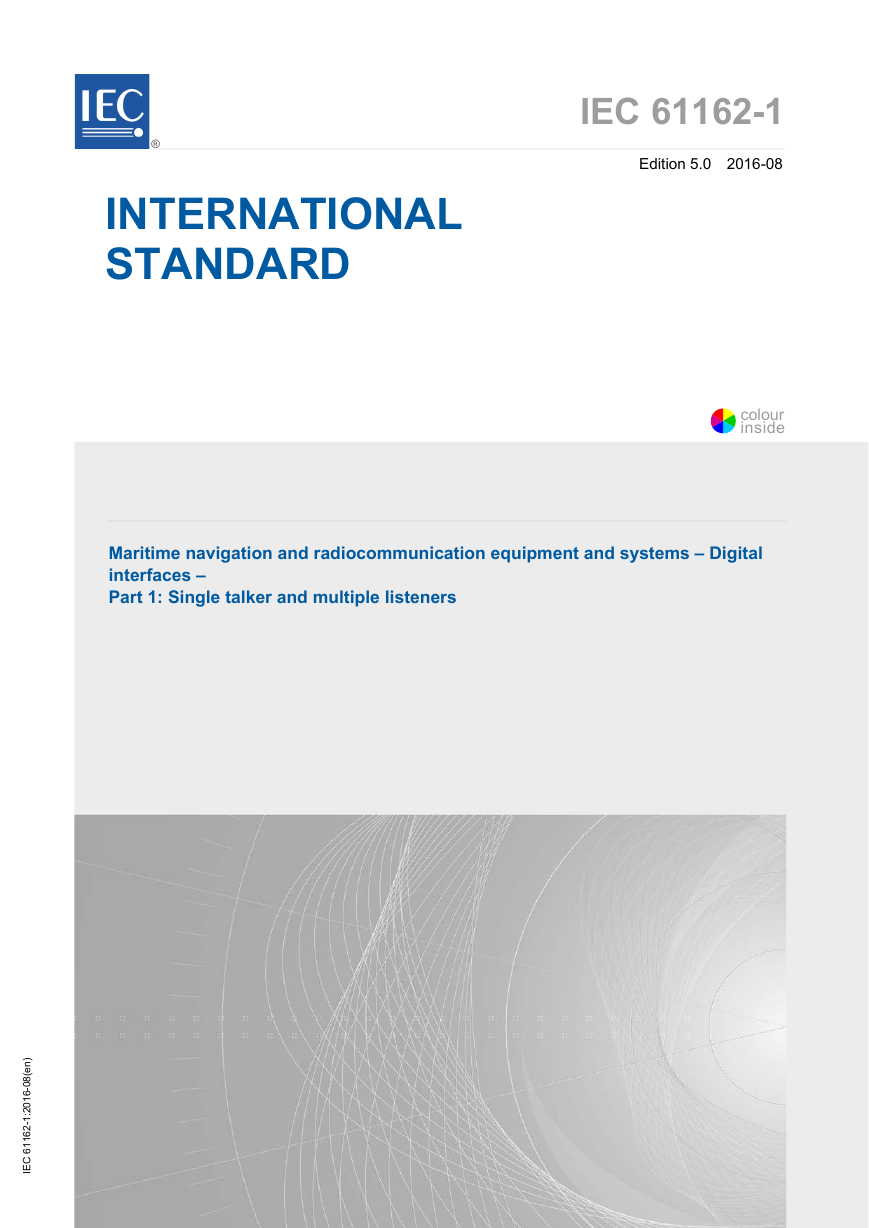
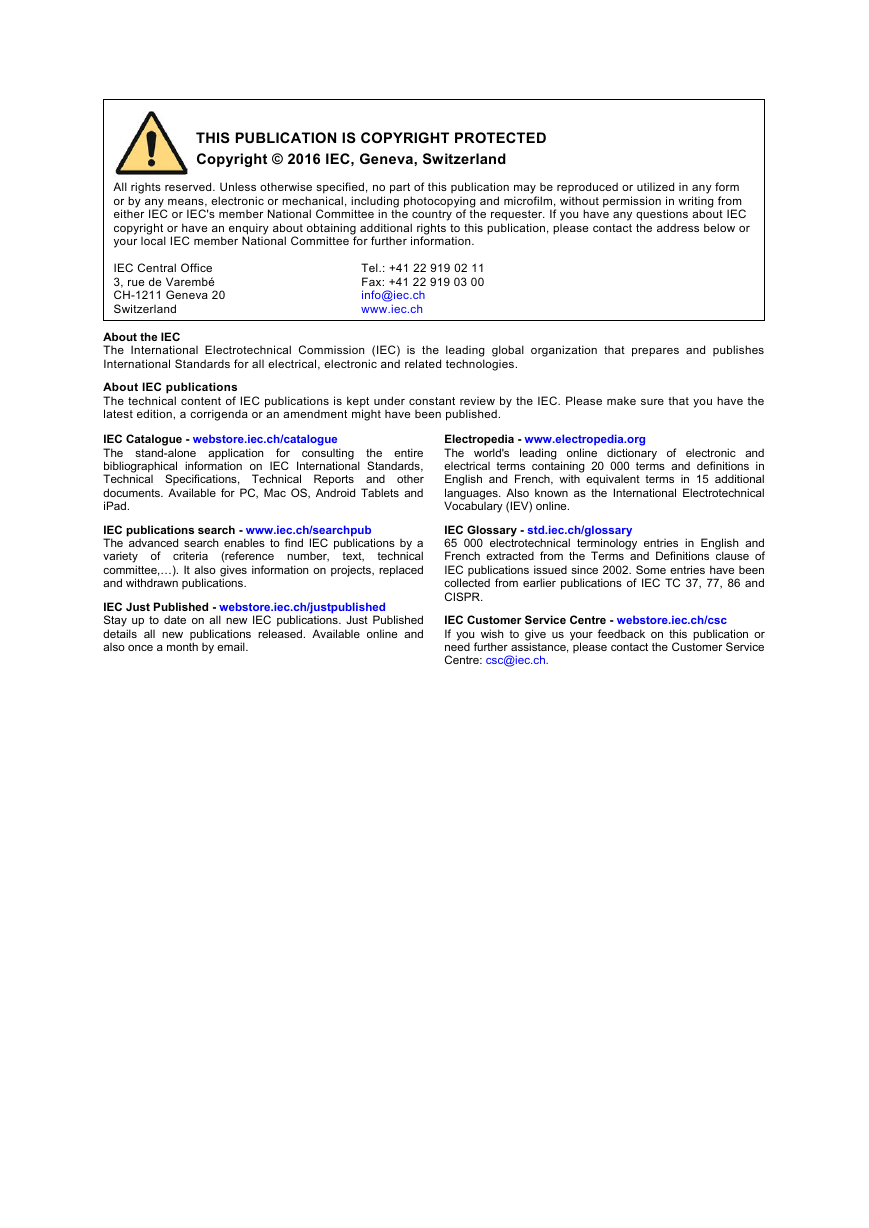
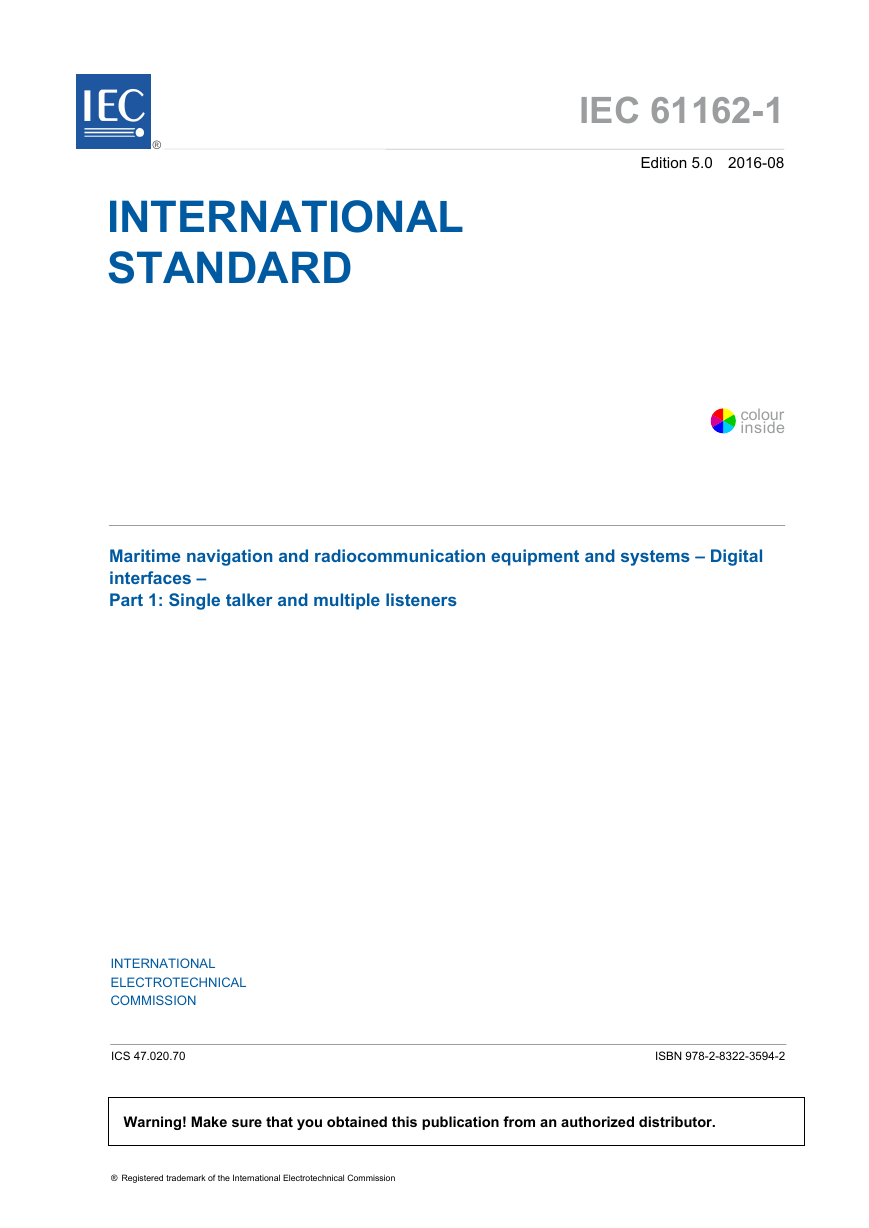
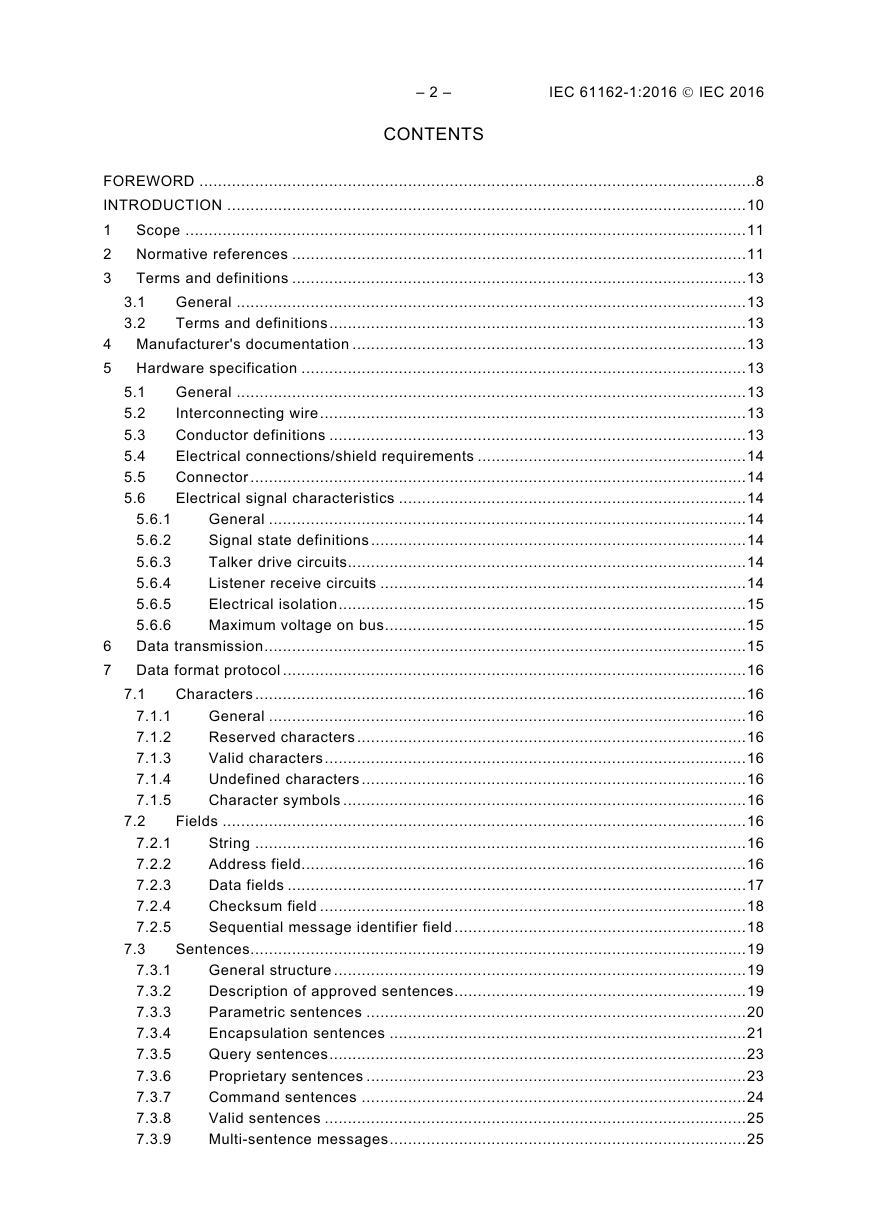
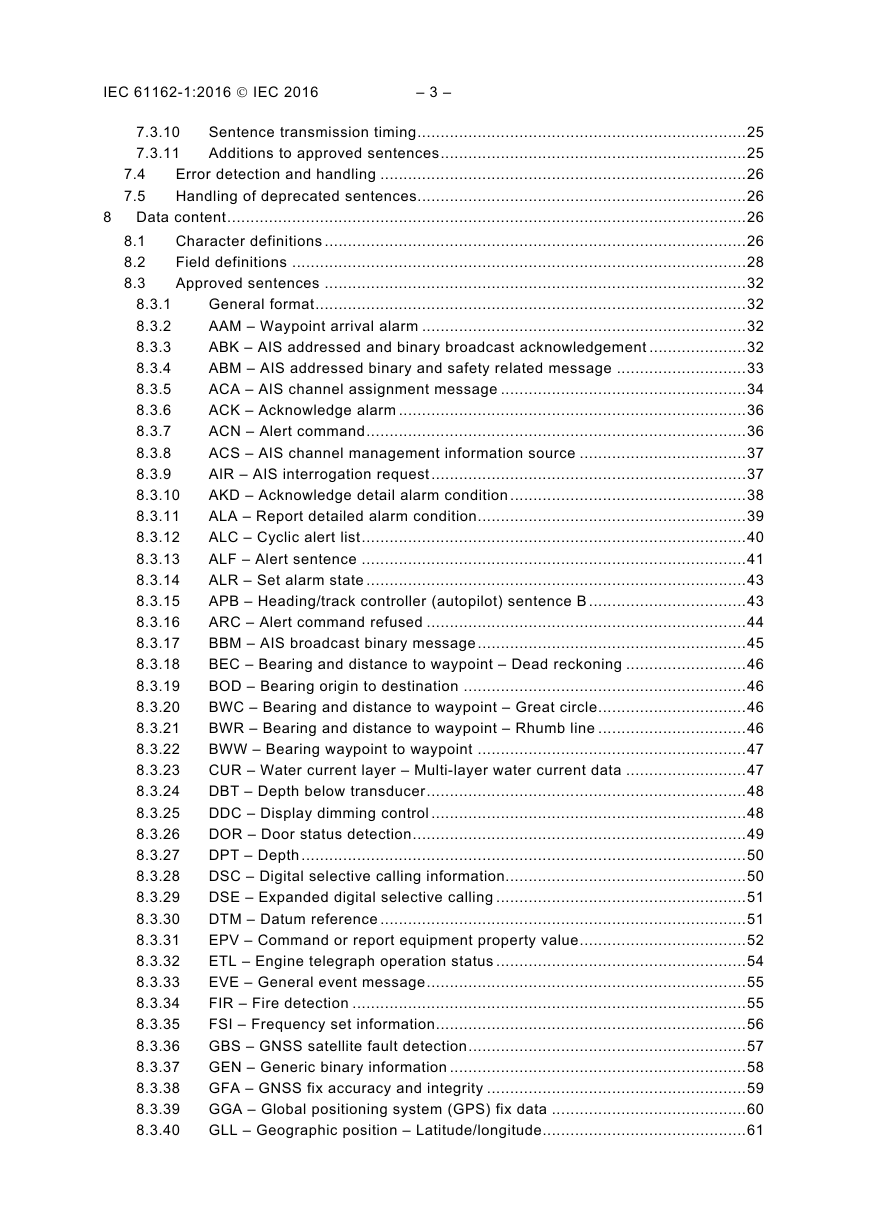
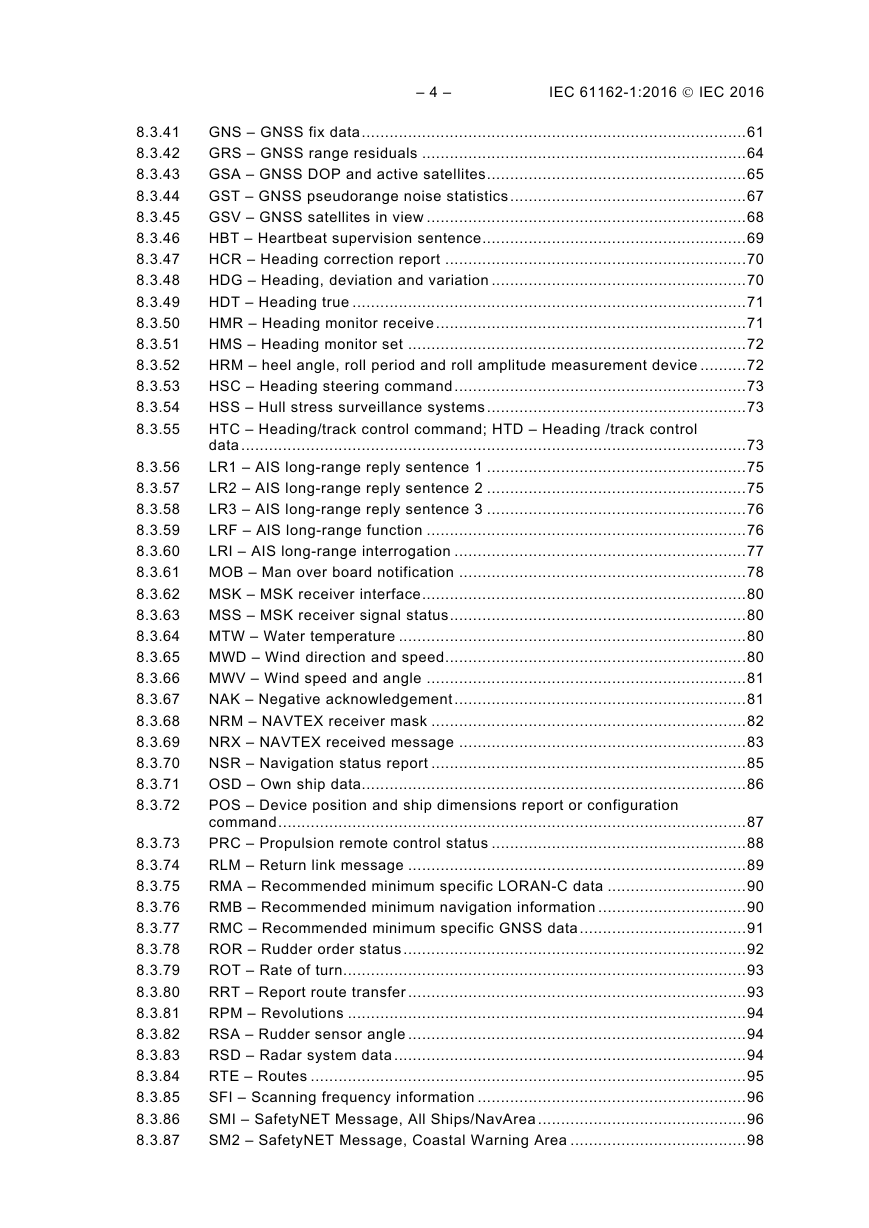










 2023年江西萍乡中考道德与法治真题及答案.doc
2023年江西萍乡中考道德与法治真题及答案.doc 2012年重庆南川中考生物真题及答案.doc
2012年重庆南川中考生物真题及答案.doc 2013年江西师范大学地理学综合及文艺理论基础考研真题.doc
2013年江西师范大学地理学综合及文艺理论基础考研真题.doc 2020年四川甘孜小升初语文真题及答案I卷.doc
2020年四川甘孜小升初语文真题及答案I卷.doc 2020年注册岩土工程师专业基础考试真题及答案.doc
2020年注册岩土工程师专业基础考试真题及答案.doc 2023-2024学年福建省厦门市九年级上学期数学月考试题及答案.doc
2023-2024学年福建省厦门市九年级上学期数学月考试题及答案.doc 2021-2022学年辽宁省沈阳市大东区九年级上学期语文期末试题及答案.doc
2021-2022学年辽宁省沈阳市大东区九年级上学期语文期末试题及答案.doc 2022-2023学年北京东城区初三第一学期物理期末试卷及答案.doc
2022-2023学年北京东城区初三第一学期物理期末试卷及答案.doc 2018上半年江西教师资格初中地理学科知识与教学能力真题及答案.doc
2018上半年江西教师资格初中地理学科知识与教学能力真题及答案.doc 2012年河北国家公务员申论考试真题及答案-省级.doc
2012年河北国家公务员申论考试真题及答案-省级.doc 2020-2021学年江苏省扬州市江都区邵樊片九年级上学期数学第一次质量检测试题及答案.doc
2020-2021学年江苏省扬州市江都区邵樊片九年级上学期数学第一次质量检测试题及答案.doc 2022下半年黑龙江教师资格证中学综合素质真题及答案.doc
2022下半年黑龙江教师资格证中学综合素质真题及答案.doc